Child Benefit Statistics: annual release, data as at August 2021
Updated 25 November 2022
Overview
This National Statistics publication includes details of the number of families claiming Child Benefit as at 31 August 2021, the number and ages of children within those families and their geographical location. Population counts at country and English region level are shown, as well as by local authority and parliamentary constituency (Westminster and Scottish) in the United Kingdom.
Contact details
For queries or feedback on this publication, please contact:
For press queries, please contact:
Main points
As at 31 August 2021, there were:
- 7.74 million families were claiming Child Benefit, a fall of approximately 95,000 when compared to a year earlier
- 7.09 million families in receipt of Child Benefit payments, a fall of approximately 122,000 when compared to a year earlier
- 13.32 million children registered in Child Benefit claims, a fall of approximately 183,000 when compared to a year earlier
- 12.31 million children in Child Benefit payment recipient families, a fall of approximately 215,000 when compared to a year earlier
Figure 1: Number of families and children in receipt of Child Benefit payments
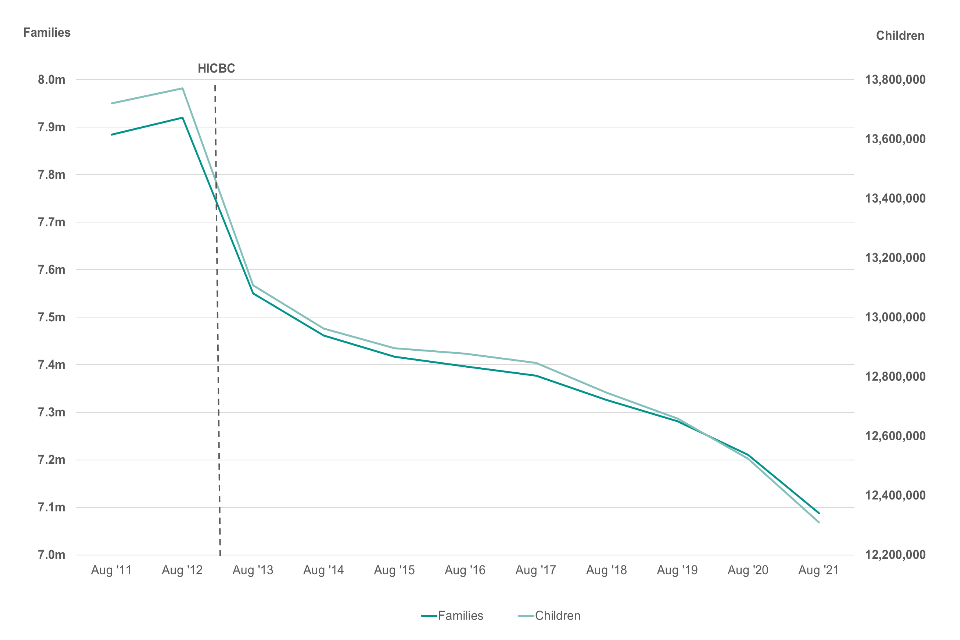
(Source data: HMRC Child Benefit administrative data)
Figure 2: Number of families in receipt of Child Benefit payments by region
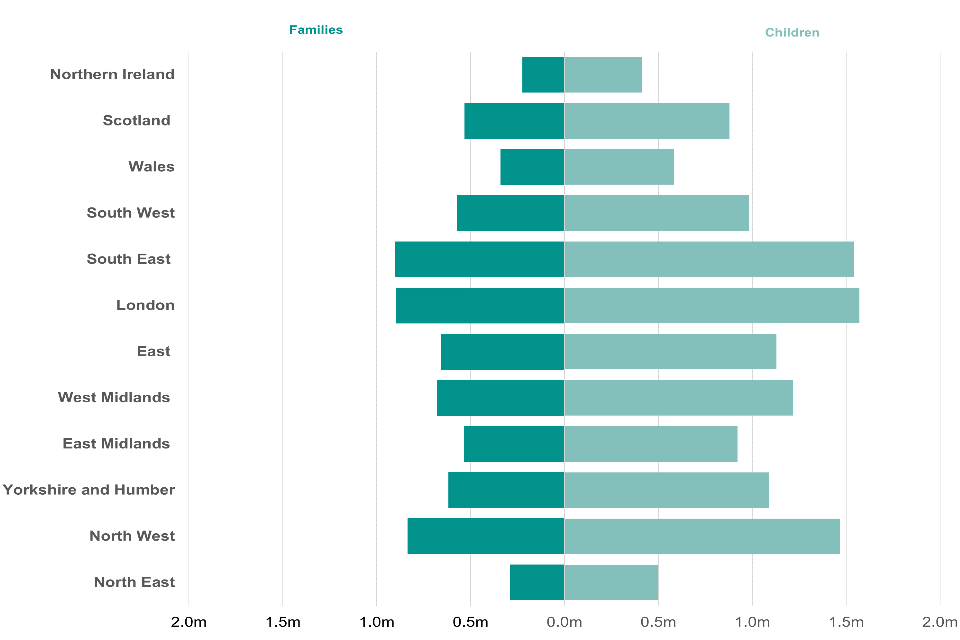
(Source data: HMRC Child Benefit administrative data)
About the data in this release
The latest data on Child Benefit for August 2021 shows that the Coronavirus (COVID-19) pandemic has not resulted in a change to the downwards trend in families claiming Child Benefit or the number of children in Child Benefit recipient families.
Over the pandemic period, the rate of decline in families receiving Child Benefit payments has accelerated, with a fall of 1.7% in the year to August 2021, compared to 1.0% in August 2020 and 0.6% in August 2019. The latest annual fall is the largest percentage reduction since the introduction of High Income Child Benefit Charge (HICBC) in 2013.
There may be a number of factors which could be driving this accelerated fall in Child Benefit recipients. These may include a fall in birth rates as indicated in the ONS provisional births data for England and Wales and the potential for take-up of new Child Benefit claims to have been interrupted by the effects of national lockdowns.
Overall trends in the time series
Figure 3: The number of families in receipt of Child Benefit payments and the number of children for whom Child Benefit payment is received, 2011 to 2021

(Source data: HMRC Child Benefit administrative data)
As at 31 August 2021, there were approximately 7.09 million families and 12.31 million children in receipt of Child Benefit payments. This is a decrease of 122,000 families and 215,000 children when compared to August 2020.
These numbers do not include those who have claimed Child Benefit but chose to opt out of receiving payment since the HICBC was introduced in January 2013. See more information on the HICBC.
Prior to August 2013, there was significant growth in the number of families in receipt of Child Benefit payments and children for whom Child Benefit payment was received. However, following the introduction of the HICBC in January 2013, these figures decreased sharply.
The effects of HICBC can also be seen in the 2021 statistics. Following the sharp decrease in August 2013, there has been a downward trend in the number of families and children for whom Child Benefit payment is received. In August 2021, the number of children for whom Child Benefit payment is received is at its lowest level since HM Revenue & Customs (HMRC) began producing these statistics in 2003.
Figure 4: The number of families claiming Child Benefit payments broken down by family size, August 2011 to August 2021
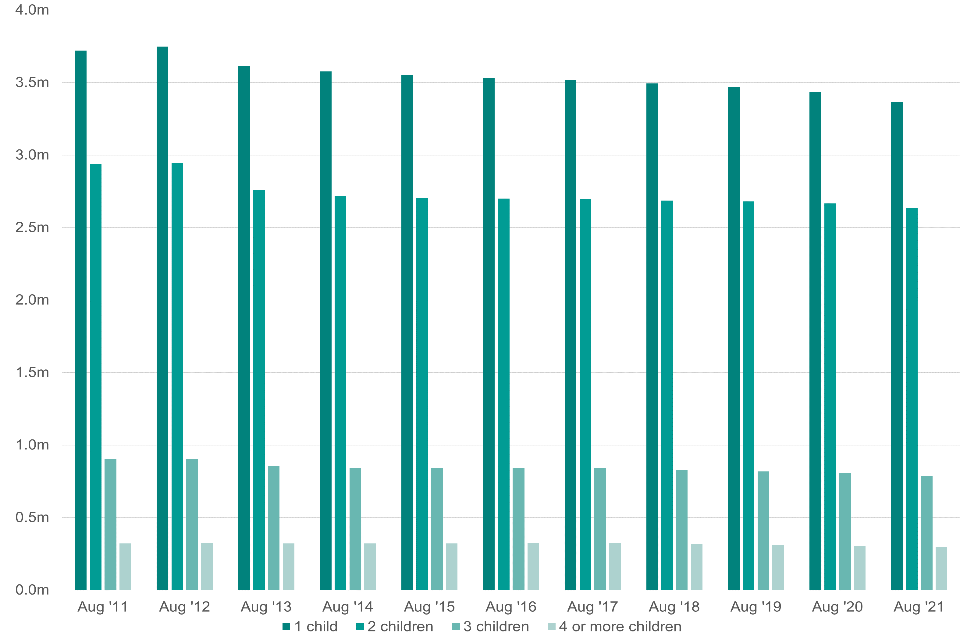
(Source data: HMRC Child Benefit administrative data)
In August 2021, there were 3.37 million families receiving Child Benefit payments for one child and 2.64 million families with two recipient children. This continues the downward trend seen since the introduction of the HICBC in January 2013.
Families in receipt of Child Benefit payments for three children has generally seen a steady decline since 2011, with a net fall of approximately 114,000. This figure stands at 788,000 in 2021.
Families in receipt of Child Benefit payments for four or more children has remained fairly stable. Although the yearly change within this group has fluctuated between 2011 and 2021, the net change over this entire period amounted to approximately 25,000. The figure for 2021 stands at 297,000.
Figure 5: The number of children for whom Child Benefit payment is received by age group, August 2011 to August 2021
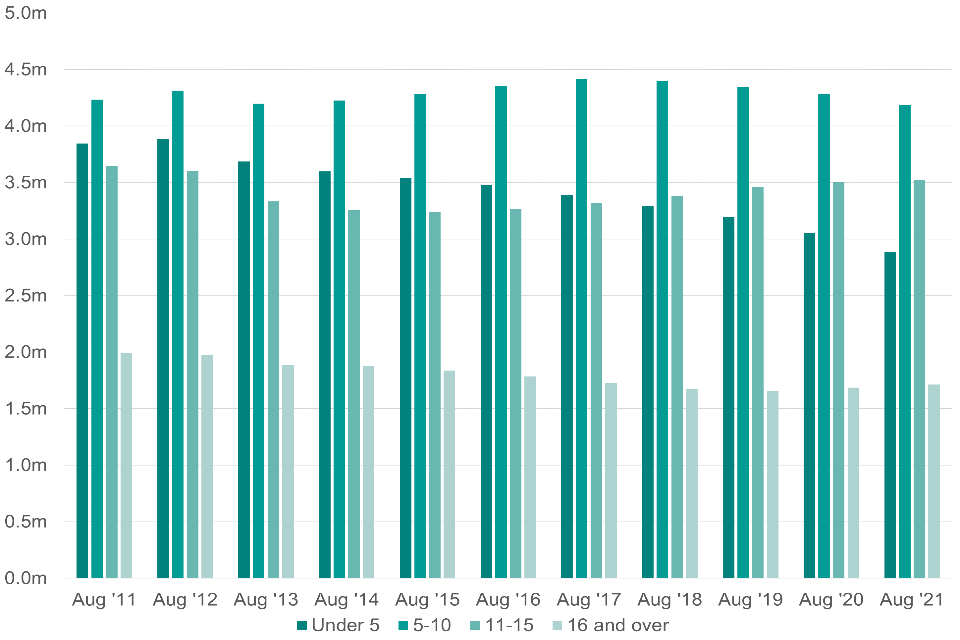
(Source data: HMRC Child Benefit administrative data)
The number of children aged under 5 for whom Child Benefit payment is received has seen a steady downward trend since 2012 and fell by a further 5.4% to 2.89 million in the year to August 2021.
The number of children aged between 5 and 10 in receipt of Child Benefit payment has fluctuated since 2011. However, from 2017 the number of children within this group has fallen each year, standing at 4.18 million in 2021.
Children aged between 11 and 15 receiving Child Benefit payments declined each year between 2011 and 2015. Since then, this group has experienced an increase of 287,000 to 3.53 million in 2021.
Payments received for children aged 16 and over fell from 2011 through to 2019, then increased by 28,000 to 1.69 million in 2020 and by 27,000 to 1.71 million in 2021.
Figure 6: The number of families in receipt of Child Benefit payments and children for whom Child Benefit payment is being received, by country and English region at August 2021
| Country and Region | Families | Children |
|---|---|---|
| North East | 290,375 | 497,065 |
| North West | 835,200 | 1,467,985 |
| Yorkshire and the Humber | 618,350 | 1,090,005 |
| East Midlands | 534,175 | 922,060 |
| West Midlands | 678,225 | 1,216,975 |
| East of England | 655,880 | 1,129,850 |
| London | 895,845 | 1,571,295 |
| South East | 902,495 | 1,542,700 |
| South West | 571,995 | 981,030 |
| Wales | 339,995 | 585,145 |
| Scotland | 532,180 | 878,235 |
| Northern Ireland | 224,335 | 411,405 |
(Source data: HMRC Child Benefit administrative data)
Figure 6 shows that in a continuing trend from August 2020, South East, London and the North West have the highest number of families in receipt of Child Benefit payments and children for whom Child Benefit payment is received. This is in line with the population estimates produced by the Office of National Statistics (ONS)
Figure 7: Average number of children for whom Child Benefit payment is received per family by country and English region at August 2021
| Region and Country | Average Number of children (2021) |
|---|---|
| North East | 1.71 |
| North West | 1.76 |
| Yorkshire and the Humber | 1.76 |
| East Midlands | 1.73 |
| West Midlands | 1.79 |
| East of England | 1.72 |
| London | 1.75 |
| South East | 1.71 |
| South West | 1.72 |
| Wales | 1.72 |
| Scotland | 1.65 |
| Northern Ireland | 1.83 |
(Source data: HMRC Child Benefit administrative data)
Figure 7 shows that, in the UK, the average number of children for whom Child Benefit payment is being received per recipient family is 1.74. The majority of the English regions and Wales fall between +/- 0.03 of this average, with the exception of Northern Ireland, West Midlands and Scotland. When compared to a year earlier, the average in each region and country has remained stable.
Figure 8: The proportion and number of Child Benefit payment recipient families by gender of claimant at August 2021
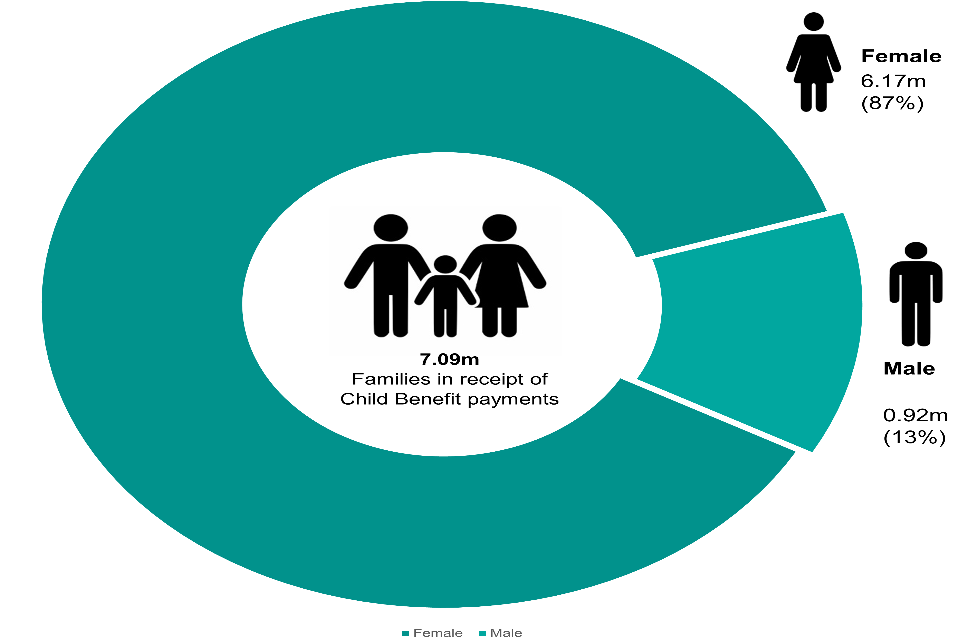
(Source data: HMRC Child Benefit administrative data)
In August 2021, 87% (6.17 million) of families in receipt of Child Benefit payments had a female as the registered claimant and 13% (0.92 million) had a male registered as the claimant.
Migration from the Child Benefit Computer System (CBCS) to the Child Benefit System (CBS) has led to improvements in designatory information that accompanies Child Benefit data. This has decreased the number of cases with an unknown gender from 43,000 in 2020 to 450 (0%) cases in 2021.
Take-up rate of Child Benefit
Families have 3 choices when their child is born. They can claim Child Benefit and receive payments, they can claim and opt-out of payments or they can choose not to claim. The table below shows estimated take-up rates for Child Benefit as a proportion of eligible children. This includes those receiving payments and those who have opted out of payments.
The central estimate of the Child Benefit take-up rate in the 2019 to 2020 tax year is 91%. This represents a fall of 1% when compared with the previous year. The Child Benefit take-up rate represents the proportion of children eligible for Child Benefit who are registered by their parents in Child Benefit claims.
Table 1: Caseload take-up rate percentages of Child Benefit by bounds, 2010 to 2020
| Lower bound | Central bound | Upper bound | |
|---|---|---|---|
| 2010 to 11 | 95 | 96 | 97 |
| 2011 to 12 | 95 | 96 | 96 |
| 2012 to 13ǂ | 96 | 96 | 97 |
| 2013 to 14ǂǂ | 95 | 95 | 96 |
| 2014 to 15ǂǂ | 95 | 96 | 96 |
| 2015 to 16ǂǂ | 94 | 94 | 95 |
| 2016 to 17ǂǂ | 92 | 93 | 93 |
| 2017 to 18ǂǂ | 92 | 93 | 94 |
| 2018 to 19ǂǂ | 91 | 92 | 93 |
| 2019 to 20ǂǂ | 90 | 91 | 91 |
ǂ First nine months of 2012 to 13, prior to the introduction of the HICBC.
ǂǂ Includes children who are eligible for Child Benefit, but who do not receive payment due to the HICBC.
The Child Benefit take-up rate is calculated using three separate data sources. These are:
-
administrative data: used to calculate the caseload – the estimated number of children and young people who are registered for Child Benefit claims, regardless of whether their parents have opted out of Child Benefit payments as part of HICBC
-
the Family Resources Survey (FRS): a household survey carried out by Department for Work and Pensions (DWP), which includes information on family circumstances and income and can be used to determine families’ entitlement to Child Benefit
-
the Labour Force Survey (LFS): a quarterly household survey which covers education and training activities of young people aged 16 and over
Figure 9: The number of children for whom Child Benefit is claimed (including HICBC payment opt-outs) and ONS population projections by age at August 2021
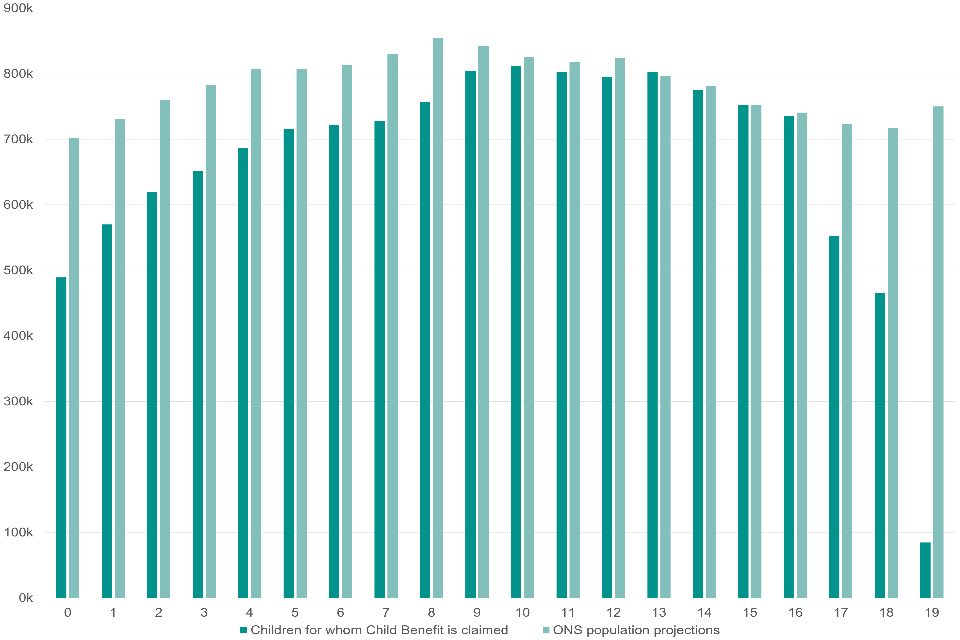
(Source data: HMRC Child Benefit administrative data and ONS population projections for UK)
Figure 9 shows that the number of children aged between 9 and 16 who are registered in a Child Benefit claim is very close to, or slightly below, the ONS population projections for the same age.
For younger children, there is an increasing proportion who are not registered in a claim. This difference is largely explained by the introduction of the HICBC, which meant that some families no longer claim for Child Benefit, knowing that they would need to pay a tax charge or opt-out of payment.
The difference between Child Benefit data and ONS projections is largest for children aged 17 to 19. This is because these children are only included within Child Benefit claims if they meet the eligibility criteria for non-advanced further education or training.
Over the year to August 2021, the largest percentage change in children in receipt of Child Benefit by age was among children aged 19, falling by 7%.
Children aged 0 also experienced a fall of 7%, following a fall of 9% in 2020. This reduction for newborns will in part be due to reduced births, as ONS provisional births data for England and Wales suggests that births in Quarter 1 (January to March) of 2021 decreased by 3.9% compared to the same period in 2020 (based on birth notification data).
Families that have opted out of receiving Child Benefit payment
In January 2013, the government introduced the HICBC. This is a tax charge which does not affect a child’s entitlement but the Child Benefit recipient will be liable to pay some or all of their entitlement if their income (or their partner’s income) is in excess of £50,000 per year. For every £100 an individual earns in excess of £50,000 the tax charge increases by 1%. This means that if the registered Child Benefit claim recipient (or the recipient’s partner) earns £60,000 or more, they will be liable to repay their entire Child Benefit entitlement. If the registered Child Benefit claim recipient is affected by the HICBC (because either they or their partner earns in excess of £50,000) they can choose to “opt-out” of receiving payments and negate the need to pay the HICBC.
Figure 10: The number of families and children that have opted out of Child Benefit payment, broken down by country and region at August 2021
| Country and Region | Families | Children |
|---|---|---|
| North East | 14,865 | 22,840 |
| North West | 51,635 | 79,705 |
| Yorkshire and the Humber | 36,090 | 55,790 |
| East Midlands | 37,160 | 57,740 |
| West Midlands | 40,370 | 62,615 |
| East of England | 85,800 | 132,935 |
| London | 114,165 | 171,785 |
| South East | 151,875 | 236,710 |
| South West | 47,060 | 75,070 |
| Wales | 15,410 | 23,985 |
| Scotland | 45,465 | 70,395 |
| Northern Ireland | 9,170 | 16,035 |
(Source data: HMRC Child Benefit administrative data)
Figure 10 shows that the East of England, London and the South East have the highest number of families that have opted out of receiving Child Benefit payment.
Figure 11: The number of children in families that have opted out of receiving Child Benefit payment by individual age at August 2021
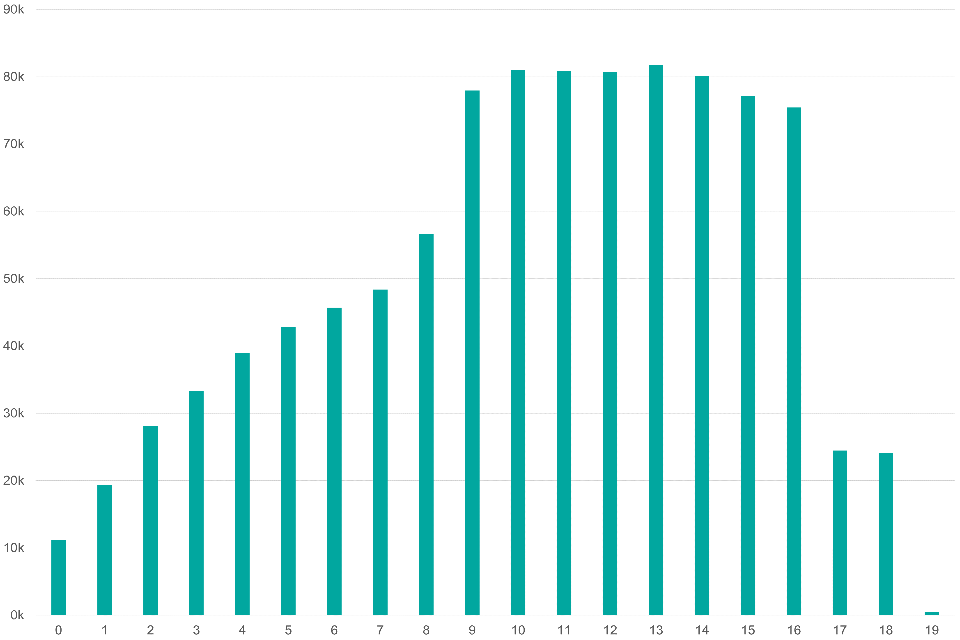
(Source data: HMRC Child Benefit administrative data)
The lower number of children at ages 8 or younger is likely to be because families subject to the HICBC (either the potential recipient or recipient’s partner earns more than £50,000) will have the option of claiming and then opting out of receiving payment or not claiming to begin with. Those who have opted out may also not inform Child Benefit when they have subsequent children since they know that they won’t receive any payment.
For children aged 16 and above, there are likely to be fewer families registered as having opted-out of receiving Child Benefit payments. This is due to the eligibility criteria for this particular age group, who need to confirm that they are still in full-time non-advanced education.
Once a child has reached the age of 12, National Insurance credits are no longer received. Therefore, there is little incentive for the family to confirm that the child is continuing in non-advanced further education and to continue to be registered as an opt-out.
Figure 12: The proportion and number of Child Benefit families that have opted out of receiving Child Benefit payment by gender of registered claimant at August 2021

(Source data: HMRC Child Benefit administrative data)
In August 2021, 85% of families that had chosen to opt-out of receiving Child Benefit payments were registered as having a female claimant and 15% were registered as having a male claimant. The total number of families that have opted out of receiving Child Benefit payments increased by 27,000 when compared to the previous year.
Migration from the Child Benefit Computer System (CBCS) to the Child Benefit System (CBS) has led to improvements in designatory information that accompanies Child Benefit data. This has decreased the number of cases with an unknown gender from 29,000 in 2020 to 5 (0%) cases in 2021.
Background and technical information
What is Child Benefit?
Child Benefit is a payment that you can claim for your child. It is usually paid every four weeks but in some cases can be paid weekly. The payment can be claimed by anyone who qualifies.
As of January 2013, claimants may be liable to a tax charge called the HICBC. Being liable for this charge does not affect a child’s entitlement but any Child Benefit recipient is liable to repay some or all of their Child Benefit back if they or their partner has an individual income of more than £50,000 per year.
For every additional £100 over the £50,000 threshold that an individual earns, the tax charge due increases by 1%. This means that any recipient whose income (or partner’s income) is £60,000 or higher will be liable to repay their entire Child Benefit entitlement. Alternatively, claimants affected by the HICBC have the option to opt-out of receiving Child Benefit, thereby ceasing their payments.
Child Benefit is paid to those responsible for children (aged under 16) or qualifying young people. The latter includes those who meet one or more of the following:
-
in full-time non-advanced education or (from April 2006) on certain approved vocational training courses and who are under 19, or are aged 19 and have been on the same course since their 19th birthday (note: those reaching 19 up to 9 April 2006 ceased to qualify on their 19th birthday)
-
entered for future external examinations, or are in the period between leaving education (or exams finishing) and the week containing the first Monday in September (or similar dates after Easter and in early January, if earlier), and are not in work (there are slight variations for Scotland)
-
aged under 18 who have moved directly from full-time education to being registered for work or training with the Careers service or with Connexions
You can receive Child Benefit for a child that does not live with you. However, if your child lives with someone else, you can only receive Child Benefit if:
-
you pay towards the upkeep of your child
-
what you pay is at least the same as the amount of Child Benefit you get for your child
-
the person bringing up your child is not getting Child Benefit for them - if you and another person both claim Child Benefit for the same child, only one of you can receive it
You do not have to be a parent to claim Child Benefit, however you do need to be responsible for a child.
Awards are also subject to residence criteria being satisfied. Under UK domestic law a family is eligible to receive Child Benefit if they are present and ordinarily resident in the UK. Citizens of European Economic Area (EEA) countries are able to claim Child Benefit as long as they meet the requirements of the right to reside test, which amongst other requirements means that they must generally be in employment, in self-employment, be self-sufficient, or be a student. From 30 June 2021, families from EEA countries are required to apply for European settled status to continue receiving or make a new Child Benefit claim.
There are two separate amounts, with a higher amount for your eldest (or only) child and a lower amount for each of your other children. Following a 4 year freeze in Child Benefit payments between 2016 to 2017 and 2019 to 2020, and a 1.7% rise in tax year 2020 to 2021, Child Benefit payments have risen by 0.5% in tax year 2021 to 2022. This has resulted in Child Benefit payments increasing from £21.05 to £21.15 per week for the eldest child, and for each subsequent child increasing from £13.95 to £14.00 per week.
For further information about who can claim please refer to the HMRC website
Rounding
The figures have been independently rounded to the nearest 5. This can lead to components as shown not summing to totals as shown.
